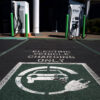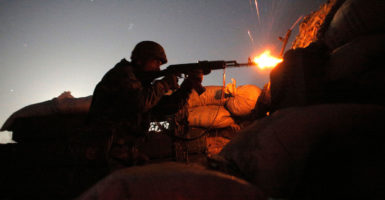KYIV, Ukraine—U.S. military aid is a luxury, not a necessity, for Ukrainian combat operations to counter Russian aggression. From what I’ve seen, the country is perfectly capable of fighting its own war—with or without the American military aid.
However, recent news reports and social media commentaries highlight the fact that Ukraine’s armed forces suffered at least 13 combat deaths during the 55 days in which the Trump administration withheld nearly $400 million in military aid from mid-July to mid-September.
The implication is that Ukraine is treading water in its war effort, suspended over the abyss of defeat at Russia’s hands only by the lift of uninterrupted U.S. military aid. The instant that assistance is cut off, this line of thinking goes, Ukraine’s ability to defend itself founders.
Well, that conclusion doesn’t jibe with what I’ve observed while covering the war, often from the front lines, since the summer of 2014.
President Donald Trump’s temporary suspension of U.S. military aid to Ukraine this summer is at the heart of a House impeachment inquiry. According to Democrats, Trump allegedly tried to leverage that defense assistance as a way to coerce Ukraine into investigating the role of Joe Biden’s son in a Ukrainian energy company. Republicans disagree, and say Trump held up the military aid over concerns about corruption in Ukraine.
U.S. military aid is clearly valuable for Ukraine’s armed forces. Yet that assistance is not life support for the country’s ongoing combat operations against Russian invasion forces in the eastern warzone.
Correlating the holdup in U.S. military aid with the rate of Ukrainian front-line casualties is a bogus conclusion, reflecting an ignorance of Ukraine’s military capabilities as well as a distorted understanding of the true nature of the war in the Donbas.
“Did Trump’s delay in providing military assistance to Ukraine have an effect on the war? I think that this delay did not have any influence on the situation in the eastern war zone,” Ukrainian army sniper Alexander Pochynok told The Daily Signal.
“As for the soldiers who were killed—blame the enemy,” Pochynok said.
Today, after five and a half years of constant combat, Ukrainian soldiers remain engaged in a trench war in the country’s eastern Donbas region against a combined force of Russian regulars, pro-Russian separatists, and foreign mercenaries.
It’s a crazy war (as if any war isn’t) in which neither side is attempting to affect a breakthrough or significantly shift the front lines’ geography. Rather, both sides are hunkered down in trenches and forts, engaged in a daily artillery slugfest for the sake of not backing down first.
To meet its daily armament expenditure requirements, Ukraine still draws heavily on Soviet-era stockpiles, not American aid.
And the vaunted U.S. Javelin anti-tank missiles delivered to Ukraine under Trump’s watch haven’t been used in combat. The missiles are stored in warehouses distant from the front lines.
“Deliveries of [American] lethal weapons, in my opinion, will primarily have psychological significance for both the Ukrainian army and the terrorists. This demonstrates the seriousness of U.S. support for Ukraine as a strategic partner,” Ukrainian army Lt. Andrei Mikheychenko told The Daily Signal, using “terrorists” to describe his combined Russian-separatist adversaries.
“However, the weapons themselves will not have a decisive impact on the course of combat operations,” Mikheychenko added. “Ukraine itself produces various types of weapons from small, to anti-tank missiles, armored vehicles, and tanks. The stocks of Soviet weapons in warehouses are also significant … these stocks will last for a long time.”
With Ukraine’s armed forces on track to become a counterbalance in Eastern Europe against a more aggressive Russia, the U.S. would do well to stay in Kyiv’s good graces. And it doesn’t take much to do so.
The $391 million in U.S. military aid that Trump temporarily withheld during the summer is a pittance compared with the $4.8 billion in aid the White House budgeted in 2020 for the Afghan National Defense Force. By that measure, U.S. military aid to Ukraine is a real bargain.
Ultimately, the real value of military aid is that it proves to Ukrainians that America is a friend worth having. And in this new era of strategic competition, America needs more friends like Ukraine—a country with a demonstrated willingness to fight for American values and a battle-hardened army at its disposal.
An Education in Modern War
In a September article in Politico headlined “How U.S. military aid became a lifeline for Ukraine,” the opening sentence reads:
“The military aid scandal that spawned the impeachment inquiry into President Donald Trump has a very different significance for Ukraine, where years of U.S. assistance have just begun to turn a ragtag army into a better-armed and professional force to counter Russian aggression.”
I disagree.
It was, in fact, the courage of Ukrainian soldiers, not U.S. military aid, which saved the country from disaster when Russia invaded in 2014.
It’s certainly true that Ukraine’s military has metamorphosed from a so-called ragtag force into a much more lethal, professional one since 2014. But it’s a stretch, in my estimation, to credit U.S. military aid for that transformation.
In fact, from what I’ve observed, the U.S. military has a lot to learn from Ukraine’s armed forces about how to fight a modern war.
Since 2014, Ukrainian troops have had their baptism by fire under Russian artillery barrages, rocket attacks, and hybrid warfare tactics. This will be their sixth straight winter spent on the eastern front, enduring the Arctic cold of the Eurasian steppe, which broke the armies of Nazi Germany and Napoleon Bonaparte.
In short, Ukrainian troops know what it’s like to fight a contemporary, conventional adversary. And that’s not a familiar experience for U.S. or NATO troops who have been preoccupied with counterinsurgency campaigns for a generation.
An unclassified report by the U.S. Army’s Asymmetric Warfare Group says:
U.S Forces should now begin contemplating how our formations should best prepare themselves for the threats that the Ukrainian Armed Forces (UAF) face and identify gaps within our own doctrine. …
America has not encountered this type of conflict for nearly a generation and needs to transform to fight and win in complex maneuver warfare.
Self-Sufficient
According to a draft budget, Ukraine’s total defense spending in 2020 is set to top $9.9 billion. That number represents 21% of the national budget and about 5.4% of Ukraine’s gross domestic product.
Of that amount, about $4.1 billion is slated for Ukraine’s armed forces, with $680 million allocated for weapons and hardware, according to a report by the Kyiv Post.
Ukraine’s national military-industrial conglomerate, Ukroboronprom, produces most of the military hardware the country needs—and has enough left over for export.
Ukraine was the world’s 12th-largest major arms exporter from 2014 to 2018 (a period spanning the war in the Donbas), according to a March report from the Stockholm International Peace Institute. That places Ukraine ahead of NATO countries such as Turkey and Canada when it comes to selling weapons abroad.
Ukraine was not among the top 40 arms importers in the world from 2014 to 2018, according to the Stockholm International Peace Institute’s report. That fact alone belies the assertion that Ukraine is beholden to American military aid—or arms imports from any other nation, for that matter—to sustain its war effort.
Still, Ukraine has a long way to go in modernizing its armed forces, many experts and officials say, especially in producing high-tech tactical battlefield technologies such as counterbattery radars and night-vision systems. Ukraine also lags in its ability to field certain big-ticket items such as warplanes and anti-aircraft defenses.
“We need to import weapons that are not manufactured in Ukraine,” said Viktor Plakhuta, an adviser to the Ukrainian parliament’s Committee on National Security and Defense.
“First and foremost are air defense and fighters,” Plakhuta told The Daily Signal. “Therefore, we need to think how to establish cooperation with the U.S. in this direction.”
In that modernization effort, U.S. aid plays a key role—particularly with better air defenses and the rebuilding of Ukraine’s air force, which Russian surface-to-air missiles devastated in the early days of the war.
That kind of American assistance goes far beyond Ukraine’s immediate war needs in the Donbas. It helps Ukraine prepare to repel a full-blown Russian invasion, as well as to adopt NATO interoperability standards.
“Russian aggression made it possible to allocate resources for the modernization [of Ukraine’s armed forces],” said Alexander Khara, deputy chairman of the Black Sea Institute of Strategic Studies, a defense research institute.
“Yet, with all the great things in the Ukrainian defense industry, we still have gaps,” Khara told The Daily Signal in an earlier interview. “We don’t produce jets and helicopters, or anti-ship missiles, though we still are able to build big ships. Given the nature of security threats, the defense demands are huge—from air defense to the navy.”
For the war in the Donbas, U.S. military aid has a more focused, tactical utility, giving Ukraine’s armed forces the modern military technology necessary to increase their survivability against Russian forces and their separatist proxies.
U.S. help also allows the Ukrainians to fight with limited means without relying on Soviet area-warfare tactics, thereby reducing the risk of collateral damage. And not to be forgotten, a U.S. training exercise that began in 2015 under the Obama administration expedited the professionalization of Ukraine’s armed forces.
U.S. support also has a symbolic value that Ukrainian soldiers sometimes exploit to rattle their enemies. I’ve observed Ukrainian soldiers speaking in English on the open radio airwaves in the war zone, pretending to be U.S. Navy SEALs or Marines. The gag usually elicits a flurry of incensed responses from their enemies.
While those benefits are significant, they’re not indispensable to Ukrainian combat operations in the Donbas. It’s also important to note that the benefits of U.S. military aid have accumulated steadily over the years through the delivery of high-tech systems such as counterbattery radars and night-vision goggles, and with the slow evolution of Ukraine’s military culture.
The 55-day holdup in U.S. aid over the summer didn’t turn off the lights on Ukraine’s war effort, nor did it instantly negate the progressively accumulated benefits of American assistance over the past five and a half years.
In the long run, however, the brief interruption in delivering U.S. military aid sent a troubling signal to Ukrainians about the long-term durability of U.S. support. That’s a message that Moscow surely picked up on, and it cuts to the heart of how U.S. military aid truly helps Ukraine.
American military assistance, while not necessary for Ukraine to meet its immediate war needs in the Donbas, certainly sends a deterrent message to Moscow. It also sends a reassuring message to Ukraine’s soldiers and civilians that they haven’t been forgotten by America.
I see U.S. military aid in a different light than most of the other commentaries you’re likely to read on that matter.
America needs to prove to Ukrainians that they made the right choice by turning away from Russia and toward the West, and that the blood and treasure Ukrainians have spent in pursuit of achieving their freedom wasn’t spent in vain.
Ukraine is on course to become a regional counterbalance to a more militarily aggressive Russia. And, looking forward, the U.S. likely will be increasingly dependent on Ukraine to hold back the Russian threat and keep the peace in Europe.
At a Ukrainian fort near the front-line town of Marinka in 2016, I asked a 30-year-old Ukrainian soldier named Andriy about the value of U.S. military aid to support his country’s war effort against a Russian invasion force.
“American help is OK. But we need to learn how to do this on our own,” said Andriy, a native of the city of Kharkiv who was then serving in the Ukrainian army’s 92nd Mechanized Brigade.
“We shouldn’t rely on other countries for help. We need to fight this war on our own,” he said, adding: “More than ammunition, we need to know we’re not alone.”
A Grassroots War Effort
After Ukraine’s 2014 “Revolution of Dignity” ousted the pro-Russian president, Viktor Yanukovych, Russia retaliated by invading and seizing Crimea the following March.
Then in April, Russian intelligence agents and special operations forces orchestrated a separatist uprising in Ukraine’s eastern Donbas region, creating two breakaway republics—the Donetsk People’s Republic and the Luhansk People’s Republic.
In the early months of the war, depleted by decades of corruption in the post-Soviet era, Ukraine’s military initially was able to field only about 6,000 combat-ready soldiers. Consequently, Russia’s hybrid offensive leapfrogged across the Donbas, taking town after town.
With Ukraine’s regular army on its heels, everyday Ukrainians filled the ranks of irregular, civilian combat units and went to war. Many of these volunteers had no prior military experience.
They learned how to be soldiers while on the front lines, under fire, with no formal training—and with little help from America during the Obama administration, apart from blankets and food rations. They were supported by legions of volunteers who raised money for basic kit and food through social media campaigns, and then drove those supplies out to the front line, often at great risk.
This motley coalition of Ukraine’s regular army and so-called volunteer battalions (the “Bad News Bears” of war, as I’ve called them) stopped the combined Russian-separatist advance. It was a grassroots war effort—an example of a society that didn’t need to be coaxed into a war by propaganda.
Ukrainians simply fought to defend their homeland when they had to.
The only experience in my lifetime analogous with what I witnessed in 2014 in Ukraine was the mood at the U.S. Air Force Academy when I was a cadet there in the days following the terrorist attacks of Sept. 11, 2001.
I remember how we were all ready to go to war, in an instant, if we had to. That’s what Ukraine was like in 2014.
“There was no army in 2014,” Ukrainian army war veteran Denys Antipov explained to me. “In my opinion, the volunteer battalions were the only reason we kept our independence. Why else would the Russian tanks have stopped in 2014?”
By July 2014, just three months into the conflict, Ukraine’s cobbled-together armed forces—that “ragtag army”—had retaken 23 out of the 36 districts previously under combined Russian-separatist control. It looked, briefly, like Ukraine might be able to take back all the territory it had lost.
But then, in August 2014, Russia invaded with thousands of its own troops, along with massive amounts of weaponry and military hardware.
According to the report by the U.S. Army’s Asymmetric Warfare Group:
The Ukrainian military and volunteer militia fought back rather successfully. They pushed the separatists back to the very border with Russia. Then everything changed. Russian regular troops with heavy equipment attacked across their border and fought a series of encirclement battles resulting in hundreds of Ukrainian troops killed and the Ukrainian Anti-Terror Operation teetering on the brink of defeat.
From an operational perspective, Russia’s original hybrid warfare plan in the Donbas was a failure. In a 2017 study, the Rand Corp. concluded that Russia’s hybrid war in eastern Ukraine failed to achieve its objectives “without resorting to conventional war and outright invasion.”
The authors went on to note: “Ukraine is a case study in the failure of hybrid warfare to deliver the desired political ends for Russia.”
A September 2014 cease-fire stopped the war from escalating to catastrophic levels. And when that first cease-fire collapsed, a second cease-fire in February 2015 known as Minsk II effectively froze the conflict along its current front line.
But the war didn’t end.
So far, the conflict in the Donbas has killed more than 13,000 —half of whom died after the Minsk II cease-fire went into effect. In October alone, another nine Ukrainian soldiers died in combat, continuing the rate of about one death every three days that has persisted for years.
And with 1.7 million Ukrainians who still can’t go home due to the conflict, Europe’s only ongoing land war is also the Continent’s biggest humanitarian crisis.
Blood and Treasure
Ukraine’s strategic military doctrine now identifies Russia as the country’s top security threat. As a result, Kyiv has rebuilt its military with the specific objective of defending against a full-blown Russian invasion and adopting NATO standards—far surpassing the immediate needs of the war in the Donbas in the process.
Today, Ukraine’s combined military ranks comprise about 250,000 active-duty troops and roughly 80,000 reservists. On the Continent, only Russia’s military is bigger.
“The funding of the army over five years has increased significantly, and this gives reason to believe that in 10 years the Ukrainian army can enter the top five armies in Europe, and even the world,” said Sergiy Tsyhipa, a former Red Army soldier who volunteered for Ukraine’s armed forces in 2015 to fight the Russian invasion.
Case in point: The reconstitution of Ukraine’s navy is specifically aimed to deter Russian aggression in the Black Sea and the Sea of Azov. In that endeavor, U.S. military aid is proving helpful.
Last week, Ukraine took possession of two retrofitted, previously decommissioned U.S. Coast Guard Island-class cutters. With more of the American vessels on the way, Ukraine’s long-term ability to project naval power to deter Russia has improved, says Andrii Ryzhenko, the Ukrainian navy’s deputy chief of staff for Euro-Atlantic integration.
“With the [U.S. Island-class cutters] we may patrol over all the Black Sea,” Ryzhenko told The Daily Signal.
As for Ukraine’s immediate defense needs, Ryzhenko singled out the beneficial impact of U.S. sanctions on Russia, which Trump has strengthened.
“This U.S. help weakens the Russians and pushes them to negotiate, thereby breaking their neo-imperial plans for the restoration of the USSR,” Ryzhenko said.






























